Past Research
Simulation and analysis of Proton Exchange Membrane Fuel Cells (PEMFCs)
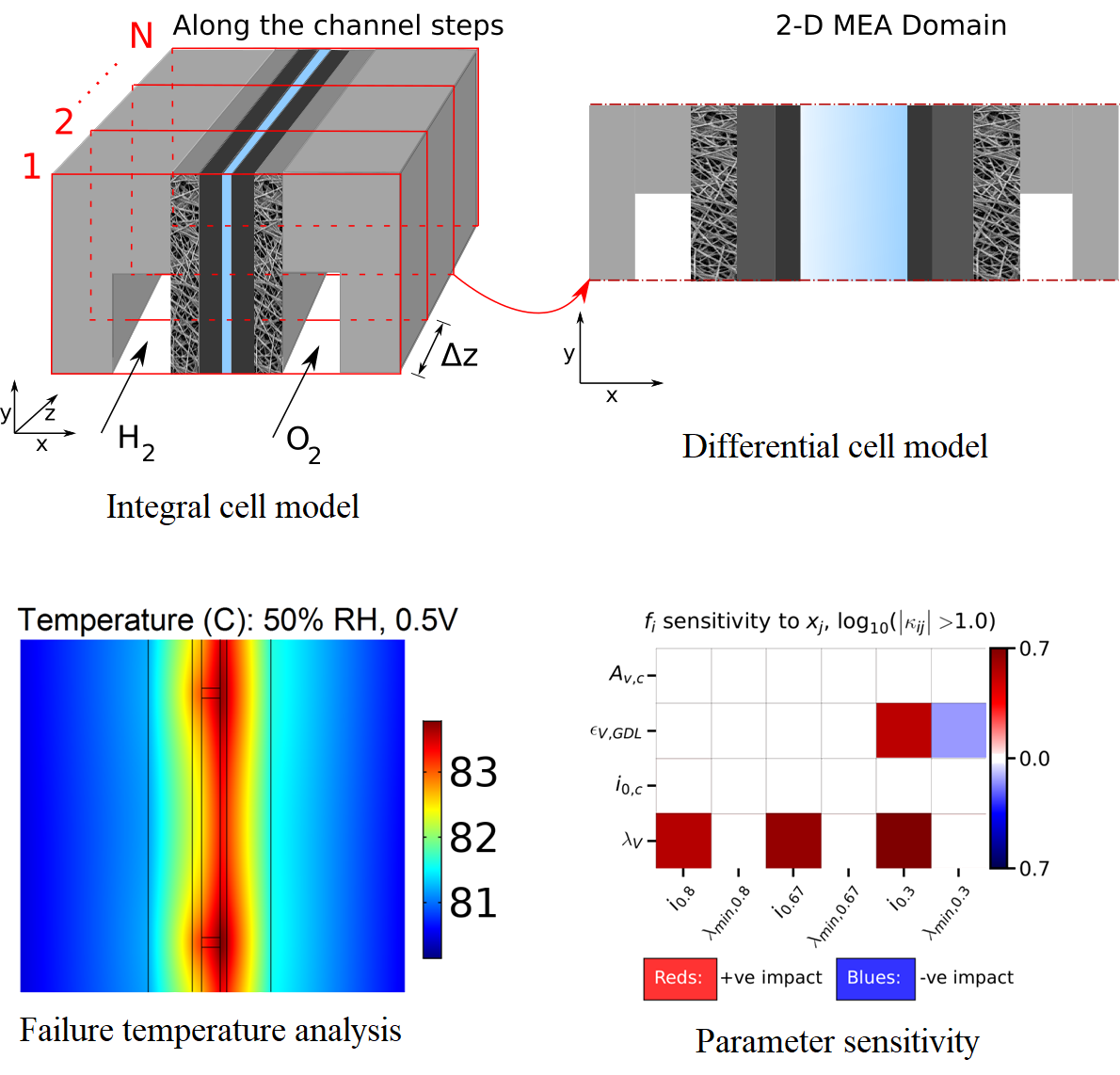 Modeling PEMFCs provides an effective way to performed detailed analysis, diagnostics, and optimization. This work was focused on developing a high-fidelity, macro-scale, multi-phase, and multi-physics simulation model which could predict PEM fuel cell performance at various operating conditions, geometric parameters, materials, and operational constraints. This model employs detailed ORR kinetics (Double-Trap), two-phase model for saturation analysis, non-isothermal framework for heat distribution, and concentrated solution theory for ion and water movement in the electrolyte. The main 2-D MEA model is coupled with an along-the-channel stepping algorithm for simulating cell in a pseudo-3D mode. A unique feature of the model in the ability to simulate the fuel cell at low stoichiometry and understand the along-the-flow effects. The model can be used to understand the internal cell health parameters, such as local hydration, reactant depletion and heat generation on cell performance. The model has been used for performance predictions, rapid diagnostics, failure analysis, and sensitive parameter estimations.
Modeling PEMFCs provides an effective way to performed detailed analysis, diagnostics, and optimization. This work was focused on developing a high-fidelity, macro-scale, multi-phase, and multi-physics simulation model which could predict PEM fuel cell performance at various operating conditions, geometric parameters, materials, and operational constraints. This model employs detailed ORR kinetics (Double-Trap), two-phase model for saturation analysis, non-isothermal framework for heat distribution, and concentrated solution theory for ion and water movement in the electrolyte. The main 2-D MEA model is coupled with an along-the-channel stepping algorithm for simulating cell in a pseudo-3D mode. A unique feature of the model in the ability to simulate the fuel cell at low stoichiometry and understand the along-the-flow effects. The model can be used to understand the internal cell health parameters, such as local hydration, reactant depletion and heat generation on cell performance. The model has been used for performance predictions, rapid diagnostics, failure analysis, and sensitive parameter estimations.
Relevent articles:
Numerical modeling of electrochemical energy systems
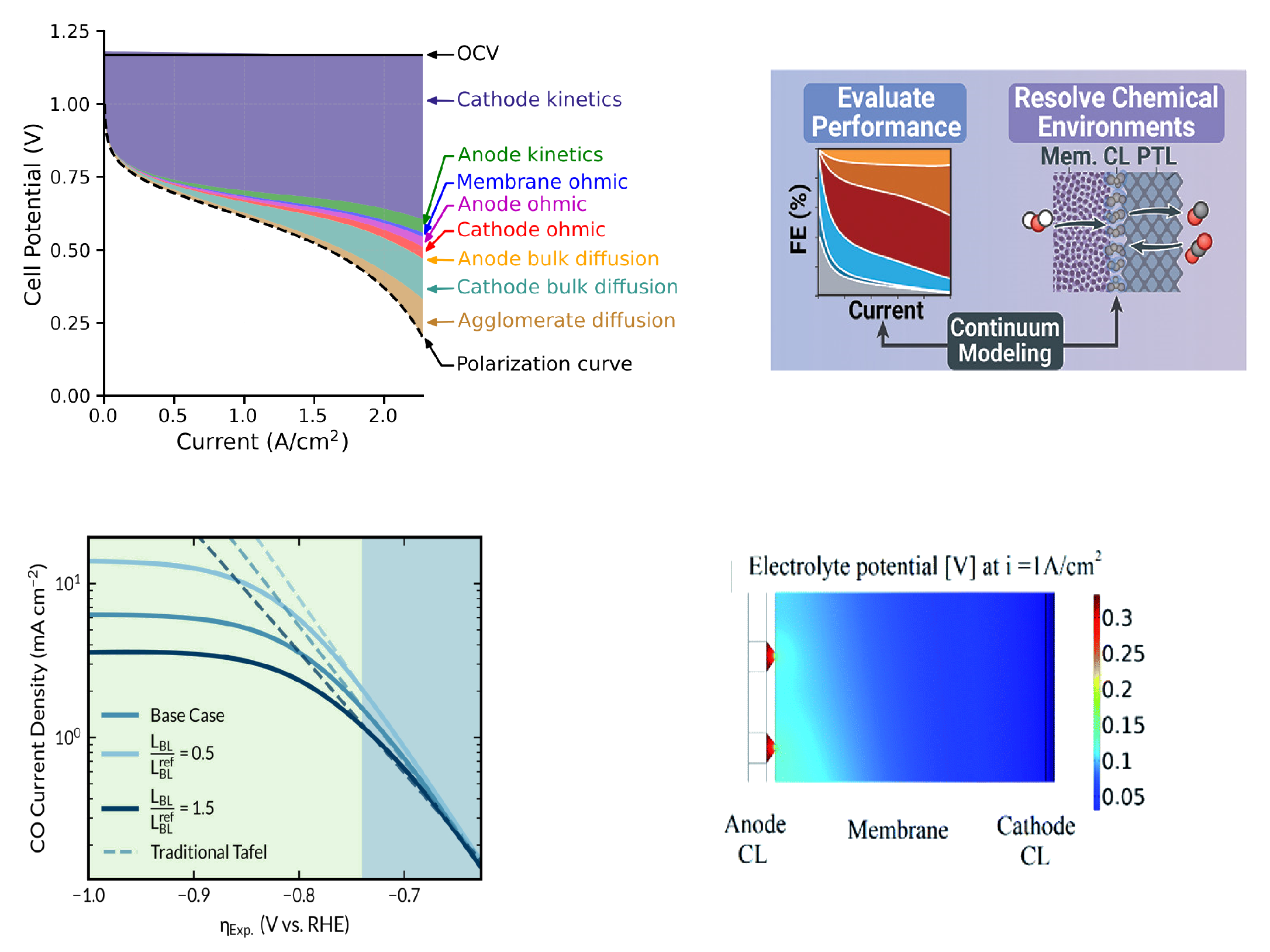 Numerical methods are idea for detailed analysis and optimization. A multiphysics model can account for different phenomena happening in a system, their interactions and associated effects on system behavior. One unique capability of numerical simulations is the ability to perform limiting case analysis and deconvolution of different physics, something that is not possible/very difficult through experimentation. Using the PEMFC framework described above, multiphysics models have been developed for AEM fuel cells, PEM/AEM electrolyzers, electrochemical synthesis, and Zn-Br battery systems.
Numerical methods are idea for detailed analysis and optimization. A multiphysics model can account for different phenomena happening in a system, their interactions and associated effects on system behavior. One unique capability of numerical simulations is the ability to perform limiting case analysis and deconvolution of different physics, something that is not possible/very difficult through experimentation. Using the PEMFC framework described above, multiphysics models have been developed for AEM fuel cells, PEM/AEM electrolyzers, electrochemical synthesis, and Zn-Br battery systems.
Relevent articles:
Porous media analysis and reconstruction
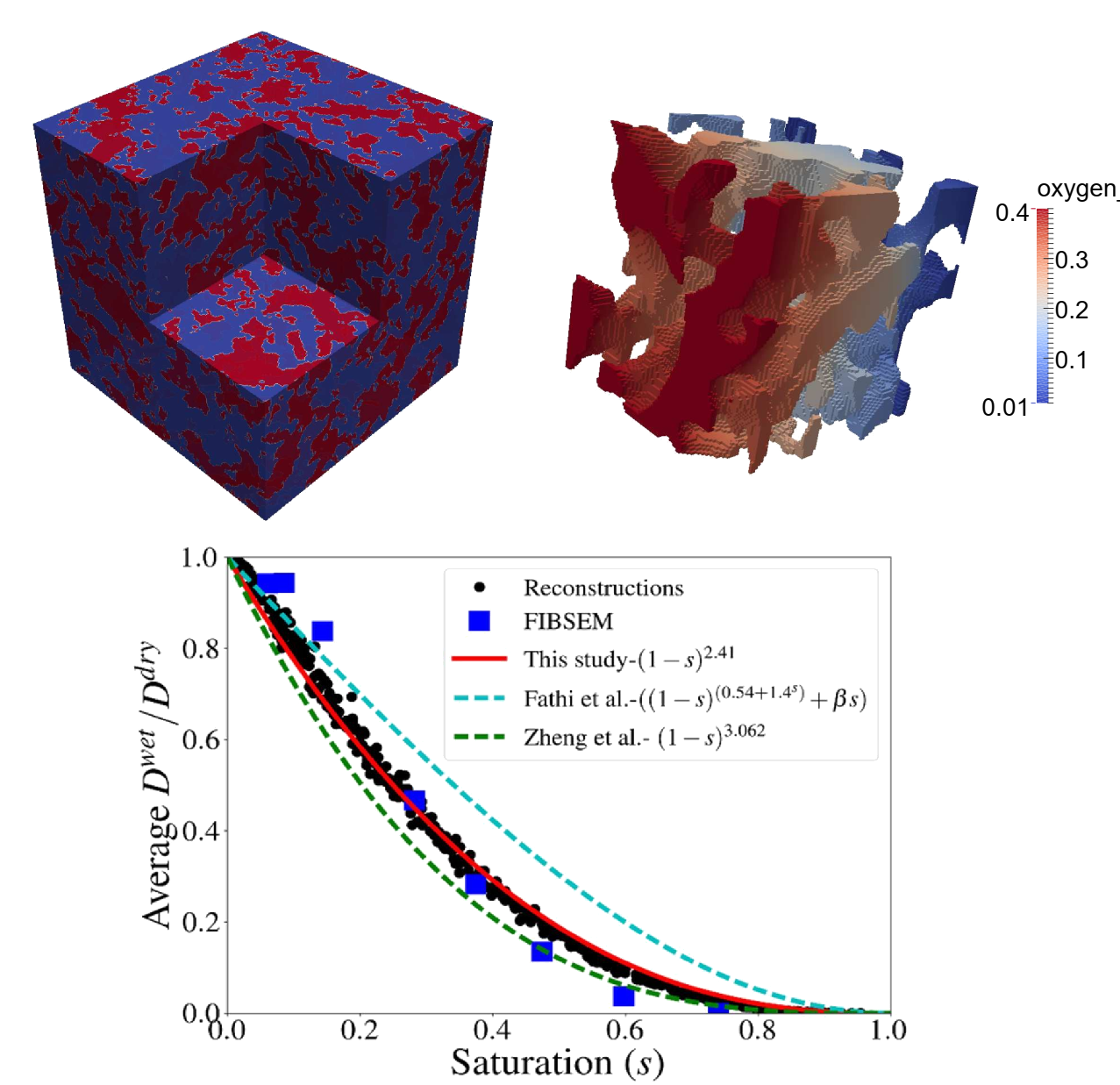 To understand the physical processes occurring in a porous media (e.g., mass, charge and energy transport in PEFC catalyst layers), numerical modeling can be used. However a detailed physical model of the porous structure is necessary for simulation purposes. During PI’s PhD, stochastic analysis and reconstruction software was developed. This software can characterize a porous media from images using statistical correlation functions. Furthermore, the software can reconstruct high accuracy porous media structures using techniques of simulated annealing. Novel methods are used to enhance the speed of reconstruction, accuracy of the reconstruction and phase connectivity of the reconstructions. The aim of the research was to characterize a porous media and its transport properties by analyzing the statistical information. The generated structures can be then used for micro-scale multiphysics simulations and to understand the localized limiting conditions. The generated PEMFC structures were used for understanding mass transport and saturation behavior.
To understand the physical processes occurring in a porous media (e.g., mass, charge and energy transport in PEFC catalyst layers), numerical modeling can be used. However a detailed physical model of the porous structure is necessary for simulation purposes. During PI’s PhD, stochastic analysis and reconstruction software was developed. This software can characterize a porous media from images using statistical correlation functions. Furthermore, the software can reconstruct high accuracy porous media structures using techniques of simulated annealing. Novel methods are used to enhance the speed of reconstruction, accuracy of the reconstruction and phase connectivity of the reconstructions. The aim of the research was to characterize a porous media and its transport properties by analyzing the statistical information. The generated structures can be then used for micro-scale multiphysics simulations and to understand the localized limiting conditions. The generated PEMFC structures were used for understanding mass transport and saturation behavior.
Relevent articles:
Measurement of porous media transport properties at transition continuum regions (Transitional Knudsen numbers)
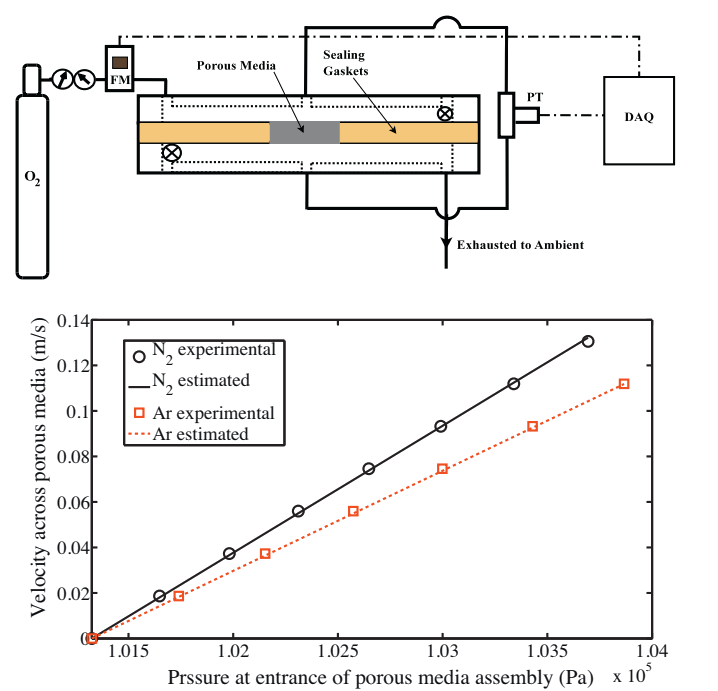 For flow at small length scales in porous media, both continuum and free-flow may be present. Conventional experiments and fitting models cannot account for this transition region. A novel approach for predicting absolute permeability, effective Knudsen diffusivity, and molecular diffusivity values in micro/nano porous media (e.g., gas-diffusion-layers/microporous layers of PEM fuel cell) was developed. A conventional diffusion bridge setup with modifications is used. The experimental results are fitted to both the Darcy’s model and the binary friction model (BFM). Experimental data obtained using different working gases, e.g. O2, N2, He and Ar, are used to validate the two model predictions.
For flow at small length scales in porous media, both continuum and free-flow may be present. Conventional experiments and fitting models cannot account for this transition region. A novel approach for predicting absolute permeability, effective Knudsen diffusivity, and molecular diffusivity values in micro/nano porous media (e.g., gas-diffusion-layers/microporous layers of PEM fuel cell) was developed. A conventional diffusion bridge setup with modifications is used. The experimental results are fitted to both the Darcy’s model and the binary friction model (BFM). Experimental data obtained using different working gases, e.g. O2, N2, He and Ar, are used to validate the two model predictions.
Relevent articles:
- Absolute Permeability and Knudsen Diffusivity Measurements in PEMFC Gas Diffusion Layers and Micro Porous Layers
- Knudsen Diffusivity and Permeability of Pemfc Microporous Coated Gas Diffusion Layers for Different Polytetrafluoroethylene Loadings
- Experimental Study of Mass Transport in PEMFCs: Through Plane Permeability and Molecular Diffusivity in GDLs
Understanding transport phenomena at small length scales
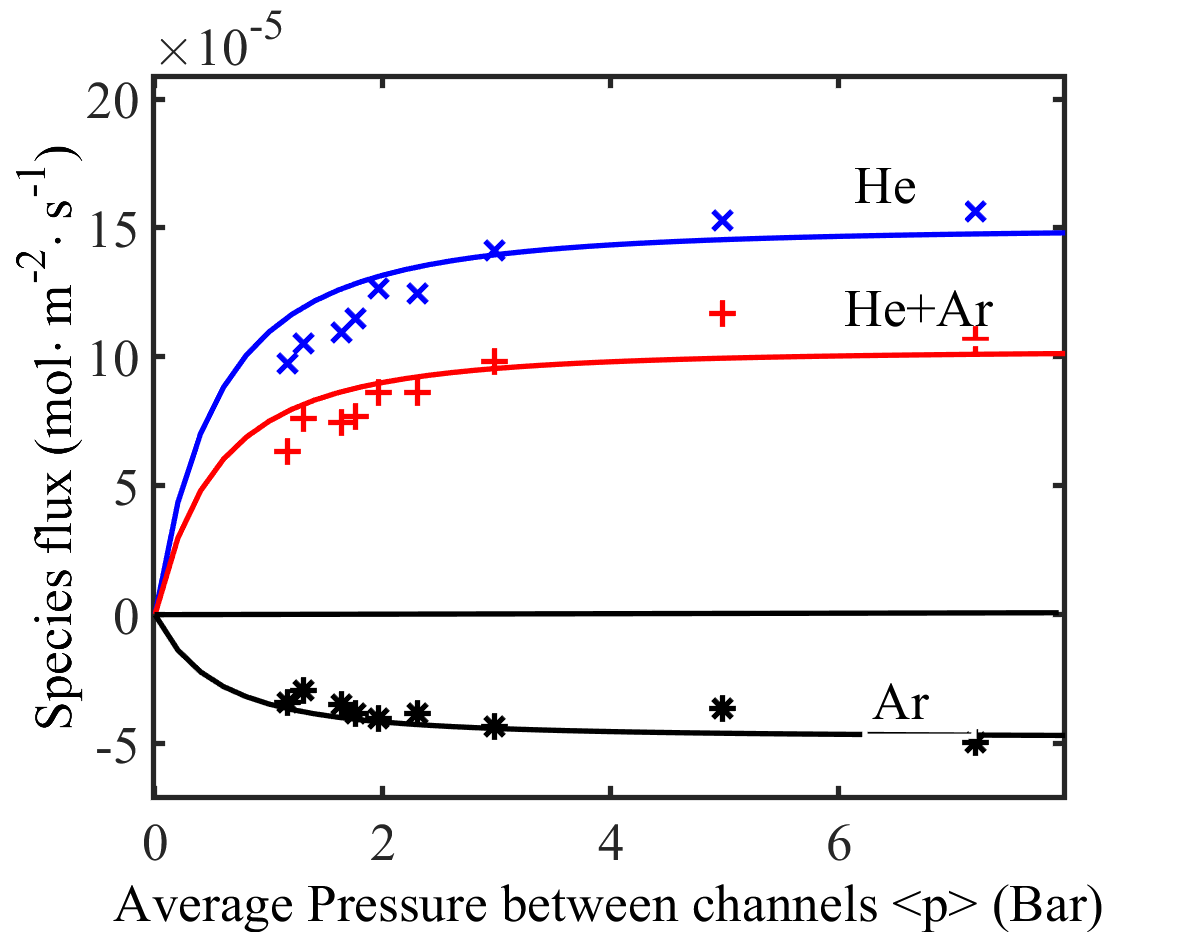 For flow at small length scales in porous media, both continuum and free-flow may be present. Most theoretical models of mass transport break down at the transition region. Few of the proposed models in the literature have inconsistencies and are not accurate. We developed a new mathematical model named Modified Binary Friction Model (MBFM) which bridges the gap between continuum flow and free-molecular flow regimes. The model was validated against transitional Knudsen region experimental data and performs well. The use of the MBFM model becomes crucial when gases with very different molecular weights are diffusing together.
For flow at small length scales in porous media, both continuum and free-flow may be present. Most theoretical models of mass transport break down at the transition region. Few of the proposed models in the literature have inconsistencies and are not accurate. We developed a new mathematical model named Modified Binary Friction Model (MBFM) which bridges the gap between continuum flow and free-molecular flow regimes. The model was validated against transitional Knudsen region experimental data and performs well. The use of the MBFM model becomes crucial when gases with very different molecular weights are diffusing together.
Relevent articles: